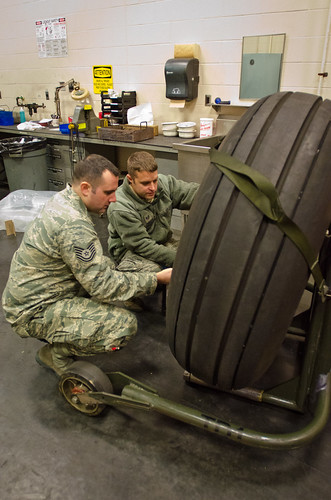Story by Master Sgt. Phil Speck, 123rd Airlift Wing Public Affairs
[caption id="" align="aligncenter" width="576"]

Tech. Sgt. Mike Johnson (right), a crew chief from the Kentucky Air National Guard's 123rd Aircraft Maintenance Squadron, shows Staff Sgt. Brian Hinckley, a crew chief from the Connecticut Air National Guard's 103rd Aircraft Maintenance Squadron, different maintenance aspects of the C-130 Hercules aircraft at the Kentucky Air National Guard base in Louisville, Ky., on Nov. 14, 2013. The Connecticut unit is converting from C-21A Learjets to the Hercules transport. (U.S. Air National Guard photo by Master Sgt. Phil Speck)
KENTUCKY AIR NATIONAL GUARD BASE, LOUISVILLE, Ky. – Airmen from Kentucky Air National Guard are extending a helping hand to another unit in the Air Guard family.
The Connecticut Air Guard’s 103rd Airlift Wing is in the process of converting from the C-21A Learjet to the C-130H Hercules transport aircraft, and Kentucky Airmen are providing maintenance training to ease the transition.
Five maintainers from Connecticut visited Louisville in early November for hands-on learning, and more are expected to follow this month, said Lt. Col. Chris Bishop, commander of Kentucky’s 123rd Aircraft Maintenance Squadron.
The Kentucky Air Guard’s 123rd Airlift Wing went through a similar airframe conversion in 1989, when the unit replaced its RF-4C supersonic reconnaissance jets with C-130s.
According to Bishop, the 103rd asked the 123rd for guidance because of its reputation for excellence. The Kentucky wing is one of the most decorated units in the U.S. Air Force, with 15 Air Force Outstanding Unit Awards.
“They reached out to us,” Bishop said. “They knew we were one of the best, and our record proves it. We’re a small family anyways, and our success is based on relationships. This was an opportunity to further develop those relationships with another unit.”
[caption id="" align="alignright" width="265"]

Tech. Sgt. Mike Johnson (right), a crew chief from the Kentucky Air National Guard's 123rd Aircraft Maintenance Squadron, speaks to Staff Sgt. Brian Hinckley, a crew chief from the Connecticut Air National Guard's 103rd Aircraft Maintenance Squadron, about the tires of the C-130 Hercules aircraft at the Kentucky Air National Guard base in Louisville, Ky., on Nov. 14, 2013. The Connecticut unit is converting from C-21A Learjets to the Hercules transport. (U.S. Air National Guard photo by Master Sgt. Phil Speck)
Airmen from the two wings first met over the summer, when the 123rd sponsored a “Maintenance University” training event at the Air National Guard’s Combat Readiness Training Center in Gulfport, Miss. It was there that the Connecticut maintainers received their first field experience with C-130 maintenance, several months prior to taking possession of their own aircraft. The 103rd now has its first Hercules airframe, which arrived in October.
The Connecticut unit has been flying C-21A Learjets since 2007. The Learjets are much smaller airframes rated for six to eight passengers, while a C-130H can carry up to 92 combat troops or 42,000 pounds of cargo, depending on the configuration. Prior to flying Learjets, the 103rd was equipped with A-10 Thunderbolt II close-air-support aircraft.
The Connecticut Air Guard is slated to receive eight C-130H aircraft — the same number assigned to Kentucky — by July.
The Connecticut Airmen have already completed some home-station training, provided by maintainers from Little Rock Air Force Base, Ark., but the visits to Kentucky give them the chance to see how C-130 maintenance is carried out on a daily basis at an operational unit, Bishop said.
The 103rd will go through some growing pains as its Airmen become familiar with their new equipment and tools, he added. They also will have to change their approach to mission planning because of the more complex logistics requirements associated with “heavy” cargo aircraft.
There will be other changes, too.
The Connecticut maintenance group is expected to double in size, according to Staff Sgt. Brian Hinckley, flight line crew chief for the 103rd Aircraft Maintenance Squadron. And timelines will be longer as they move from the svelte Learjet to the cavernous Hercules.
“Everything is bigger and slower,” Hinckley observed. “The missions are a day or two, instead of an hour or two.”
But the new airframe also means more opportunities for unit members to be globally engaged through temporary duty assignments, exercises and deployments requiring C-130 airlift capabilities.
“We’re all over-the-top excited,” Hinckley said. “We can’t wait.”
Bishop said the Kentucky maintainers are happy to assist their Connecticut colleagues, especially given the 123rd’s own history with the C-130.
“We’re a small community here in the Guard, and we help each other out when we can,” he said. “We know they would do the same for us. We got help from other units such as Mansfield, Ohio, and West Virginia when we converted to the C-130, and now we’re just returning the favor.”